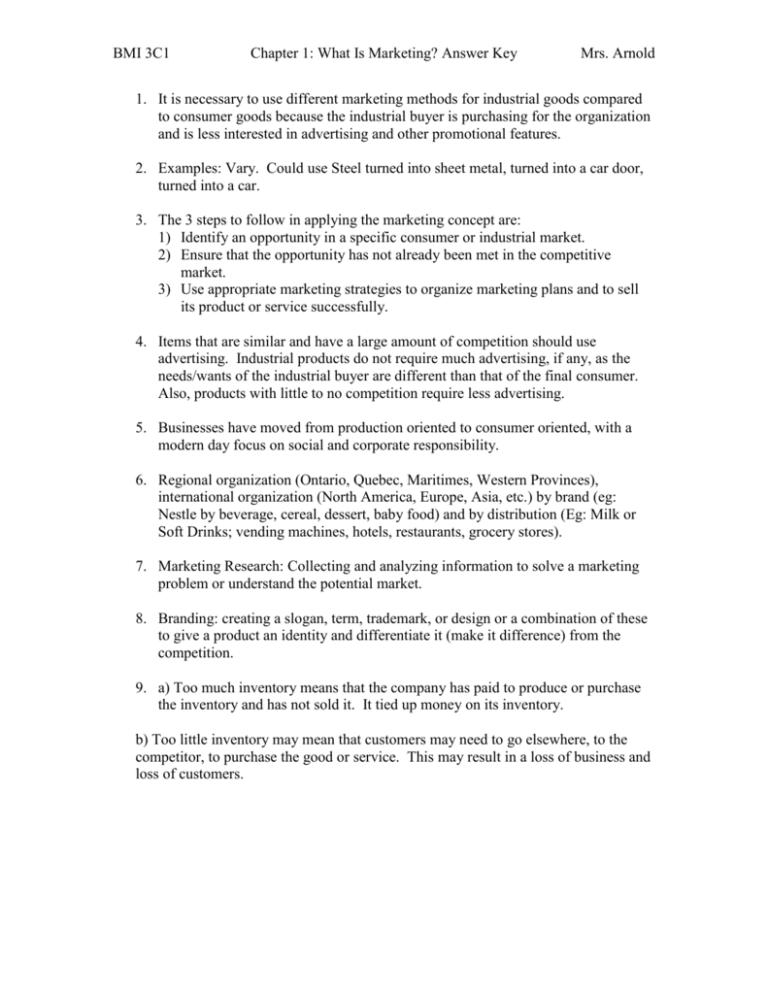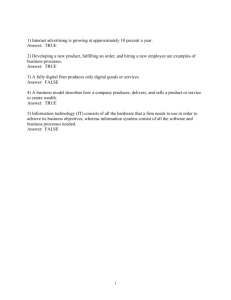It is necessary to use different marketing methods for industrial
advertisement

BMI 3C1 Chapter 1: What Is Marketing? Answer Key Mrs. Arnold 1. It is necessary to use different marketing methods for industrial goods compared to consumer goods because the industrial buyer is purchasing for the organization and is less interested in advertising and other promotional features. 2. Examples: Vary. Could use Steel turned into sheet metal, turned into a car door, turned into a car. 3. The 3 steps to follow in applying the marketing concept are: 1) Identify an opportunity in a specific consumer or industrial market. 2) Ensure that the opportunity has not already been met in the competitive market. 3) Use appropriate marketing strategies to organize marketing plans and to sell its product or service successfully. 4. Items that are similar and have a large amount of competition should use advertising. Industrial products do not require much advertising, if any, as the needs/wants of the industrial buyer are different than that of the final consumer. Also, products with little to no competition require less advertising. 5. Businesses have moved from production oriented to consumer oriented, with a modern day focus on social and corporate responsibility. 6. Regional organization (Ontario, Quebec, Maritimes, Western Provinces), international organization (North America, Europe, Asia, etc.) by brand (eg: Nestle by beverage, cereal, dessert, baby food) and by distribution (Eg: Milk or Soft Drinks; vending machines, hotels, restaurants, grocery stores). 7. Marketing Research: Collecting and analyzing information to solve a marketing problem or understand the potential market. 8. Branding: creating a slogan, term, trademark, or design or a combination of these to give a product an identity and differentiate it (make it difference) from the competition. 9. a) Too much inventory means that the company has paid to produce or purchase the inventory and has not sold it. It tied up money on its inventory. b) Too little inventory may mean that customers may need to go elsewhere, to the competitor, to purchase the good or service. This may result in a loss of business and loss of customers. BMI 3C1 Chapter 1: What Is Marketing? Answer Key Mrs. Arnold 10. Similarities Differences Nonprofit Doesn’t have profit as main motive Raises money for a specific cause (Canadian Cancer society, Heart & Stroke) Not-for-profit Doesn’t have profit as main motive Raises money for its members (child care coop, housing) 11. Consumer market refers to all those consumers who are or may be interested in a particular product or service and who have the means by which to purchase it. Competitive market comprises all the products or services that compete with one another for consumers’ money within a specific category. 12. B2B: Refers to business to business marketing. One business sells or supplies another business (industrial/institutional consumer) B2C: Refers to business to consumer marketing. A business sells to a final consumer. 13. 4P’s Product, Price, Place and Promotion. 2C’s Customer and Competition. 14. Marketing Strategy: How a company uses its marketing mix in its efforts to sell its product to its customers. Marketing Plan: A document outlining a company’s marketing strategy and how it will achieve its marketing goals. 15. Value Equation: adds all the benefits of a product, real and imagined, and subtracts all of the costs involved in obtaining the product. Benefits and costs are assigned values based on importance. 16. Varies 17. Push strategy: Sells the product to retailers, importers, or wholesalers, and not to end-use consumers. Focus marketing efforts on distributors or sellers to “push” the product to the consumer. 18. Pull strategy: Attempts to increase consumer demand directly, rather than rely on retailers to sell the product to the customer. Focus marketing efforts on final consumer to increase demand for the good/service. BMI 3C1 Chapter 1: What Is Marketing? Answer Key Mrs. Arnold 19. Push and pull strategy could be used to optimize effectiveness. Push strategy can stand alone. 20. Security/safety and inability to try on the product or see it in person. 21. Industrial good: Goods purchased for producing other goods/services (by businesses). Consumer good: goods produced for consumption by the final consumer/general public (eg: shoes, clothing, etc.) 22. Modern marketing concept evolved by increased competition and a shift in power from producers to consumers, giving consumers more choice. 23. Promotion: Advertising, sales promotion, branding, personal selling, publicity and public relations. 24. Refer to question 14.




